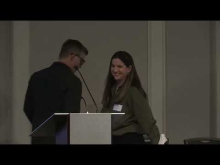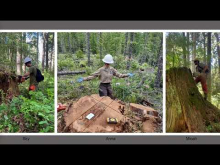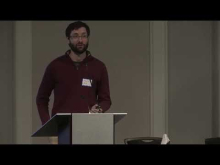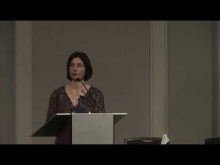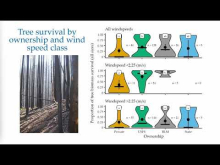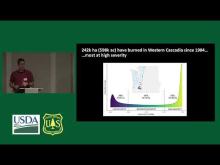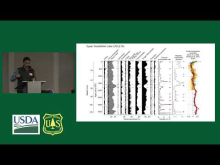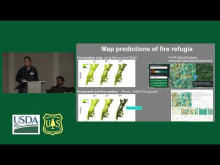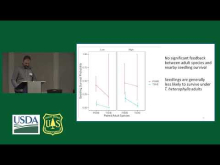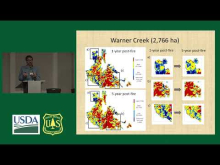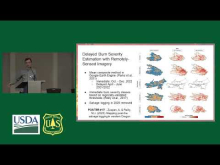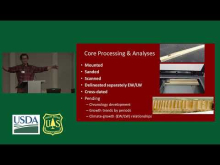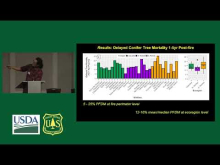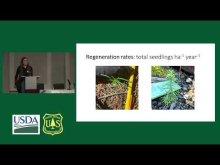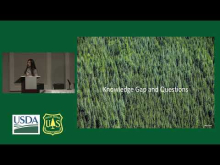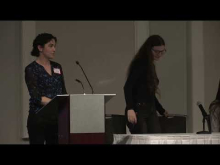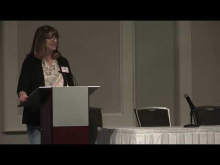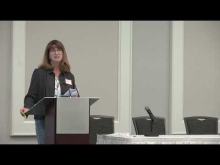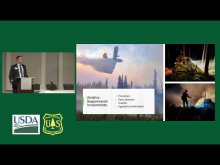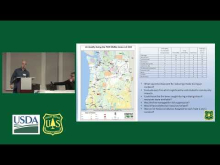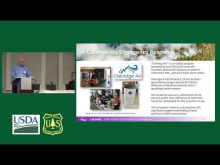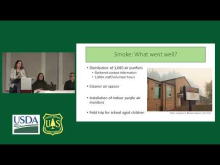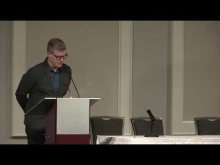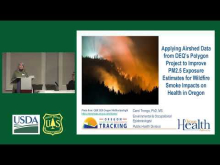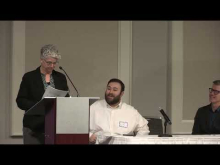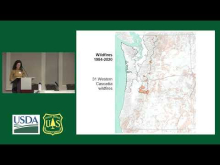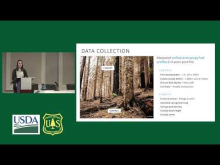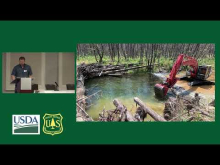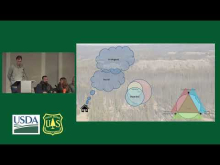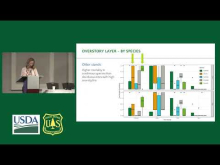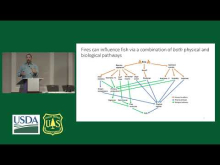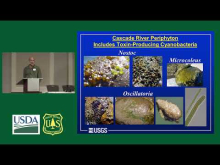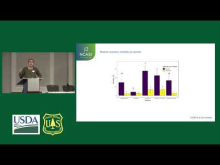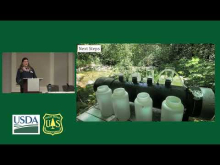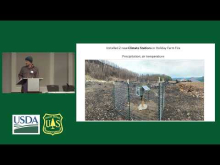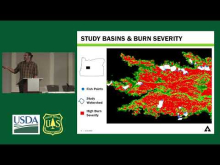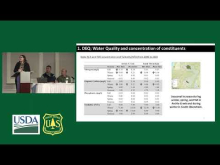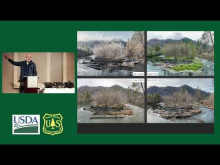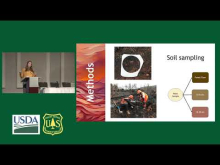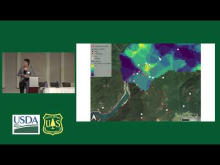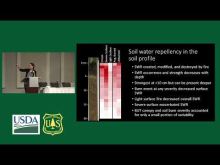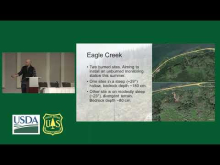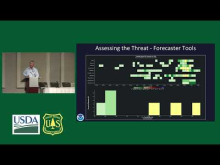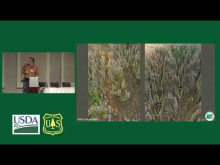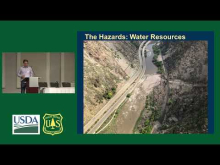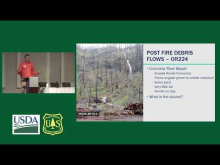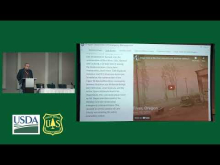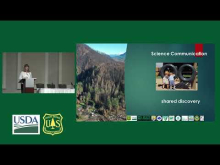Post-fire Landscapes: What can they tell us?
The Oregon Post-fire Research and Monitoring Symposium was held in Corvallis, OR on February 7th-9th, 2023. For more information:
See symposium agenda (pdf)
Collaborative Postfire Research and Monitoring page (US Forest Service, PNW Research Station)
Jump to a specific day:
Day 1: February 7, 2023
Day 1: Welcome Session
Cheryl Friesen, Science Liaison with the U.S. Forest Service, presents the opening remarks.
Day 1: Oregon Governor’s Post-fire Science Team
Jessica Halofsky, Director of the U.S. Forest Service NW Climate Hub and the Western Wildland Environmental Threat Assessment Center, and James Markweise, Chief of the Ecology Effects Branch with the U.S. Environmental Protection Agency, provide an overview of the Oregon 2020 wildfire season and the Oregon Governor’s Post-fire Science Team that was formed as a result of that fire season.
Day 1: Investigating How Present-Day and Future Climate will Influence Wildfire Talk 1
Andrew Merschel, with the U.S. Forest Service PNW Research Station and Oregon State University, presents: “800 years of post-fire forest recovery data in west-side Douglas-fir forests”.
Day 1: Investigating How Present-Day and Future Climate will Influence Wildfire Talk 2
Alex Dye, with Oregon State University, presents: “Climate change modifies future burn probability, size, and frequency of wildfires in Oregon’s West Cascades”.
Day 1: Investigating How Present-Day and Future Climate will Influence Wildfire Talk 3
Crystal Raymond, with the University of Washington, presents: “Forest fires in Western Cascadia: climatic drivers to inform climate-adaptive management responses”
Day 1: Investigating How Present-Day and Future Climate will Influence Wildfire Talk 4
Jeremy Fried, with the U.S. Forest Service PNW Research Station, presents: “FIA remeasurements within 2020 Labor Day Fires reveals supremacy of fire weather over forest structure, error associated with mapped burn severity products, and statistical estimates of live to dead carbon pool conversions”.
Day 1: Investigating How Present-Day and Future Climate will Influence Wildfire Talk 5
Brian Harvey, with the University of Washington, presents: “Spatial patterns of burn severity in Western Cascadia: characteristics, drivers, and implications for post-fire landscapes”.
Day 1: Investigating How Present-Day and Future Climate will Influence Wildfire Talk 5
E. Henry Lee, with the U.S. Environmental Protection Agency, presents: “Large influence of soil moisture on wildfires, biological disturbance agents, and tree growth in Pacific Northwest coniferous forests”.
Day 1: Investigating How Present-Day and Future Climate will Influence Wildfire Talk 6
William "Buzz" Nanavati, with Portland State University, presents: “A 3600-year history of vegetation and fire dynamics from the Bull Run Watershed Management Area, Mt. Hood National Forest”.
Day 1: Investigating How Present-Day and Future Climate will Influence Wildfire Talk 7
Cameron Naficy and Meg Krawchuck, with Oregon State University, presents: “Fire refugia, old forests, and northern spotted owls: a synthesis of key concepts, trends, and toolsets for local to regional conservation planning”.
Day 1: Investigating How Present-Day and Future Climate will Influence Wildfire Talk 9
Cole Doolittle, with Marquette University and the HJA Experimental Forest, presents: “Exploring how microclimates and biotic factors influence post-fire forest plant communities”.
Day 1: Delayed Mortality Flash Talk 1
Matthew Reilly, with the U.S. Forest Service PNW Research Station, presents: "Sizing up the elephant in the room: Remote sensing of post-fire delayed tree mortality in westside forests of the Pacific Northwest".
Day 1: Delayed Mortality Flash Talk 2
Alec Dyer, with Portland State University, presents: "Post-wildfire delayed mortality in Douglas-fire and western hemlock".
Day 1: Delayed Mortality Flash Talk 3
Andrés Holz, with Portland State University, presents: "Post-wildfire delayed mortality in Douglas-fir and western hemlock."
Day 1: Delayed Mortality Flash Talk 4
Andrés Holz, with Portland State University, presents: "Understanding drivers of post-fire delayed mortality in temperate rainforests".
Day 1: Early-Seral Flash Talk 1
Madison Laughlin, with the University of Washington, presents: "Patterns and drivers of conifer regeneration following stand-replacing wildfire in western Cascadia".
Day 1: Early-Seral Flash Talk 2
Liliana Rangel-Parra, with the University of Washington, presents: "Composition and diversity of early-seral forest communities vary with burn severity and pre-fire stand age following fire in western Cascadia".
Day 1: Early-Seral Flash Talk 3
Oriana Chafe, with the University of Washington, presents: "Twenty-year post-fire recovery in western Oregon: Tracing early seral trajectories with a spatially balanced forest inventory sample".
Day 1: Closing Remarks
Cheryl Friesen, Science Liaison with the U.S. Forest Service, presents the first day closing remarks.
Day 2: February 8, 2023
Day 2: Opening Remarks
Cheryl Friesen, Science Liaison with the U.S. Forest Service, presents the second day opening remarks.
Day 2: All Lands, All Hands: Caring for our natural and human environments
Doug Grafe, Wildfire Programs Director with the Oregon Governor's Office, presents the opening session for the second day of the Symposium title, "All Lands, All Hands: Caring for our natural and human environments".
Day 2: The Future of air quality during wildfires in western Oregon part 1
Segment one of the Panel Discussion: The future of air quality during wildfires in western Oregon. The panel facilitator is James Markweise with the U.S. Environmental Protection Agency. The panel speaker in this video is Rick Graw with the U.S. Forest Service.
Day 2: The Future of air quality during wildfires in western Oregon part 2
Segment two of the Panel Discussion: The future of air quality during wildfires in western Oregon. The panel facilitator is James Markweise with the U.S. Environmental Protection Agency. The panel speaker in this video is Steve Dietrich with Lane Regional Air Protection.
Day 2: The Future of air quality during wildfires in western Oregon part 3
Segment three of the Panel Discussion: The future of air quality during wildfires in western Oregon. The panel facilitator is James Markweise with the U.S. Environmental Protection Agency. The panel speakers in this video are Hollie Smith and Heidi Huber-Sterns with the University of Oregon.
Day 2: The Future of air quality during wildfires in western Oregon part 4 Intro
Segment four of the Panel Discussion: The future of air quality during wildfires in western Oregon. The panel facilitator is James Markweise with the U.S. Environmental Protection Agency.
Day 2: The Future of air quality during wildfires in western Oregon part 4
Segment four of the Panel Discussion: The future of air quality during wildfires in western Oregon. The panel facilitator is James Markweise with the U.S. Environmental Protection Agency. The panel speaker in this video are Tom Roick with the Oregon Department of Environmental Quality and Carol Trenga with the Oregon Health Authority.
Day 2: The Future of air quality during wildfires in western Oregon part 5
Segment five of the Panel Discussion: The future of air quality during wildfires in western Oregon. The panel facilitator is James Markweise with the U.S. Environmental Protection Agency. The panel speaker in this video are Kyle Chapman with the Oregon Institute of Technology and Cassandra Mosely of the University of Oregon.
Day 2: The Fire Continuum Talk 1
Michele Buonanduci, with the University of Washington, presents: “Examining wildfires from other regions and fire regimes yields insights into future patterns of burn severity in western Cascadia”.
Day 2: The Fire Continuum Talk 2
Jenna Morris, with the University of Washington, presents: “Impacts of forest structure and fire severity on reburn potential in western Cascadia”.
Day 2: The Fire Continuum Talk 3
Jeff McEnroe, with the U.S. Bureau of Land Management, presents: “Rock Creek post-fire restoration monitoring”.
Day 2: The next pre-fire landscape panel
This is the Panel Discussion: The next pre-fire landscape: how does a new landscape management paradigm emerge? The panel facilitator is James Dickinson with the U.S. Bureau of Land Management. The panel speakers include Andrew Puerini, Fire Management Officer with the Confederated Tribes of Grand Ronde; Rebecca A. Lloyd, instream flow hydrologist with the U.S. Forest Service; Dustin Hawks, Cultural Department Lead with the Confederated Tribes of Grand Ronde; and Barbara Garcia, Deputy Director Renewable Resource Management with the U.S. Forest Service.
Day 2: Water and Riparian Habitat Talk 1
Laura Six, Ashley Coble, and Jake Vershuyl, with NCASI, presents: "Riparian vegetation dynamics two years after mixed severity fire in the western Cascades, Oregon"
Day 2: Water and Riparian Habitat Talk 2
David Roon, with Oregon State University, presents: "Quantifying the effects of wildfire on water quantity, water quality, aquatic ecology, and fish: the Hinkle Creek Watershed Study revisited"
Day 2: Water and Riparian Habitat Talk 3
Kurt Carpenter, with the U.S. Geological Survey, presents: "Post-fire hyperspectral surveys for periphyton to protect drinking water quality in three Cascade Range rivers following the September 2020 wildfires"
Day 2: Water and Riparian Habitat Talk 4
Ashley Coble, with NCASI, presents: "Forested streams, fire, and large wood across a gradient of fire severity and forest stand age"
Day 2: Water and Riparian Habitat Talk 5
Brooke Penaluna, with the USFS, presents: "What happens to fish when their forest is on fire? Answers from 24 Oregon streams"
Day 2: Water and Riparian Habitat Talk 6
Mark River, with Weyerhaeuser Co., presents: "Holiday Farm Fire: Impacts on shade/stream temperature on private timberland"
Day 2: Water and Riparian Habitat Talk 7
Jason Walter, with Weyerhaeuser Co., presents: "Holiday Farm Fire: Impacts to the upstream extent of fish distribution in headwater streams on private timberlands"
Day 2: Fire in riparian areas panel discussion
This is the Panel Discussion: Fire in riparian areas -- implications to future water quality management. The panel facilitator is Aaron Borisenko, with the Oregon Department of Environmental Quality. Lorrayne Miralha, with Oregon State University, kicks off the panel with a presentation titled: "Spatiotemporal patterns of water quality to wildfires in the western United States". The other panel speakers include David Donahue with the Eugene Water and Electric Board; Julie Harvey with Oregon Department of Environmental Quality; and Kurt Carpenter with the U.S. Geological Survey.
Following Fire: A resilient Forest/Uncertain Future Photographic Essay
David Bayles presents a photographic essay titled: "Following Fire: A resilient forest / An uncertain future." Over two years and dozens of site visits to the Holiday Farm Fire area along the McKenzie River, we have explored the art-science interface in burned forest. The photographic work has developed along four paths: Chronosequence, Typology, Documentary and Fine Art. Each photo technique and resulting body of works open distinctive opportunity for conversation. The post-fire landscape is both devastating and starkly beautiful. The skeletal forest quickly gives way to a succession of biota (fire fungi, fire moss, fireweed), and successions of forms, colors, and processes, revealing the amazing resilience of forests. But, quickly, we sense the uncertain future posed by climate change, invasive species, and intensive forest management.
Day 3: February 9, 2023
Day 3: Post-fire Soils and Debris Flow Hazards Talk 1
Katherine McCool, with Oregon State University, presents: "Quantifying impacts of forest fire on soil carbon in a young, intensively managed tree farm in the western Oregon Cascades"
Day 3: Post-fire Soils and Debris Flow Hazards Talk 2
Hayley Peter-Contesse, with Oregon State University, presents: "Soil carbon persistence and pyrogenic carbon signature in Oregon’s Western Cascades one year post fire"
Day 3: Post-fire Soils and Debris Flow Hazards Talk 3
Brittany Johnson, with the University of Washington, presents: "Evaluating the occurrence and spatial patterns of soil water repellency in the Deschutes National Forest, Oregon"
Day 3: Post-fire Soils and Debris Flow Hazards Talk 4
Ben Leshchinsky, with Oregon State University, presents: "Evaluating the controls on post-fire debris flows in the Pacific Northwest"
Day 3: Post-fire Soils and Debris Flow Hazards Talk 5
Andy Bryant, with the National Oceanic and Atmospheric Administration, presents: "National Weather Service services for post-fire debris flow hazards in Northwest Oregon"
Day 3: Post-fire Soils and Debris Flow Hazards Talk 6
Bill Burns, with the Oregon Deparment of Geology and Mineral Industries, presents: "Recent observations of post-fire debris flows in five megafires in the western cascades, Oregon"
Day 3: Post-fire Soils and Debris Flow Hazards Talk 7
Francis Rengers, with the U.S. Geological Survey, presents: "Pairing on-the-ground observations with realtime telemetered rainfall data to develop a post-fire debris flow inventory in Oregon"
Day 3: Post-fire Soils and Debris Flow Hazards Talk 8
Michael Zimmerman, with the Oregon Department of Transportation, presents: "Dealing with post-fire soil movement in a complex human environment: the Gorge!"
Day 3: Post-fire Soils and Debris Flow Hazards Talk 9
Stan Thomas, with the Oregon Department of Emergency Management, presents: "Navigating the world of building back communities, and the importance of good science to inform hazard mitigation and post fire reconstruction."
Symposium Wrap-Up
Cheryl Friesen, Science Liaison with the U.S. Forest Service, presents the closing remarks.

